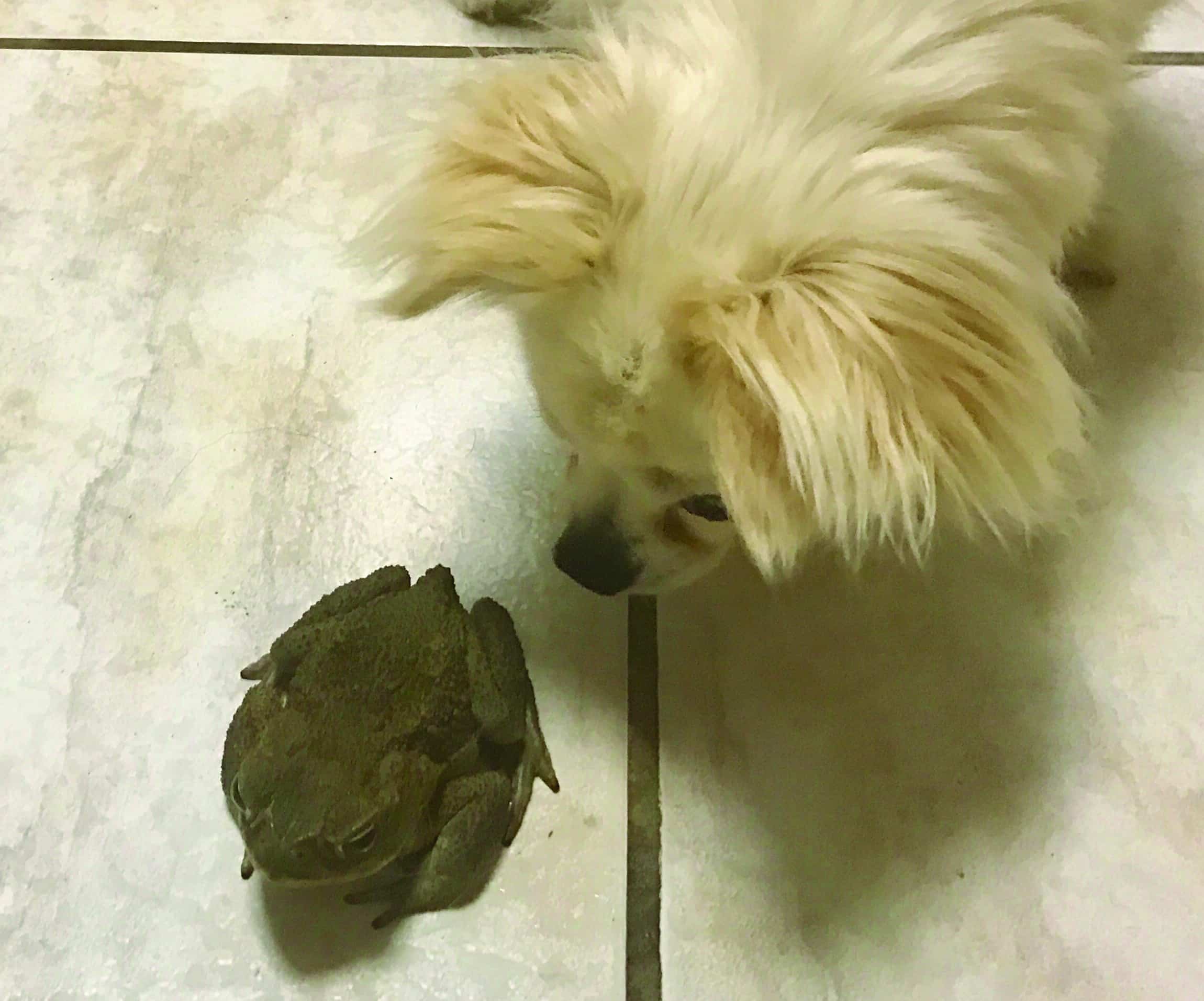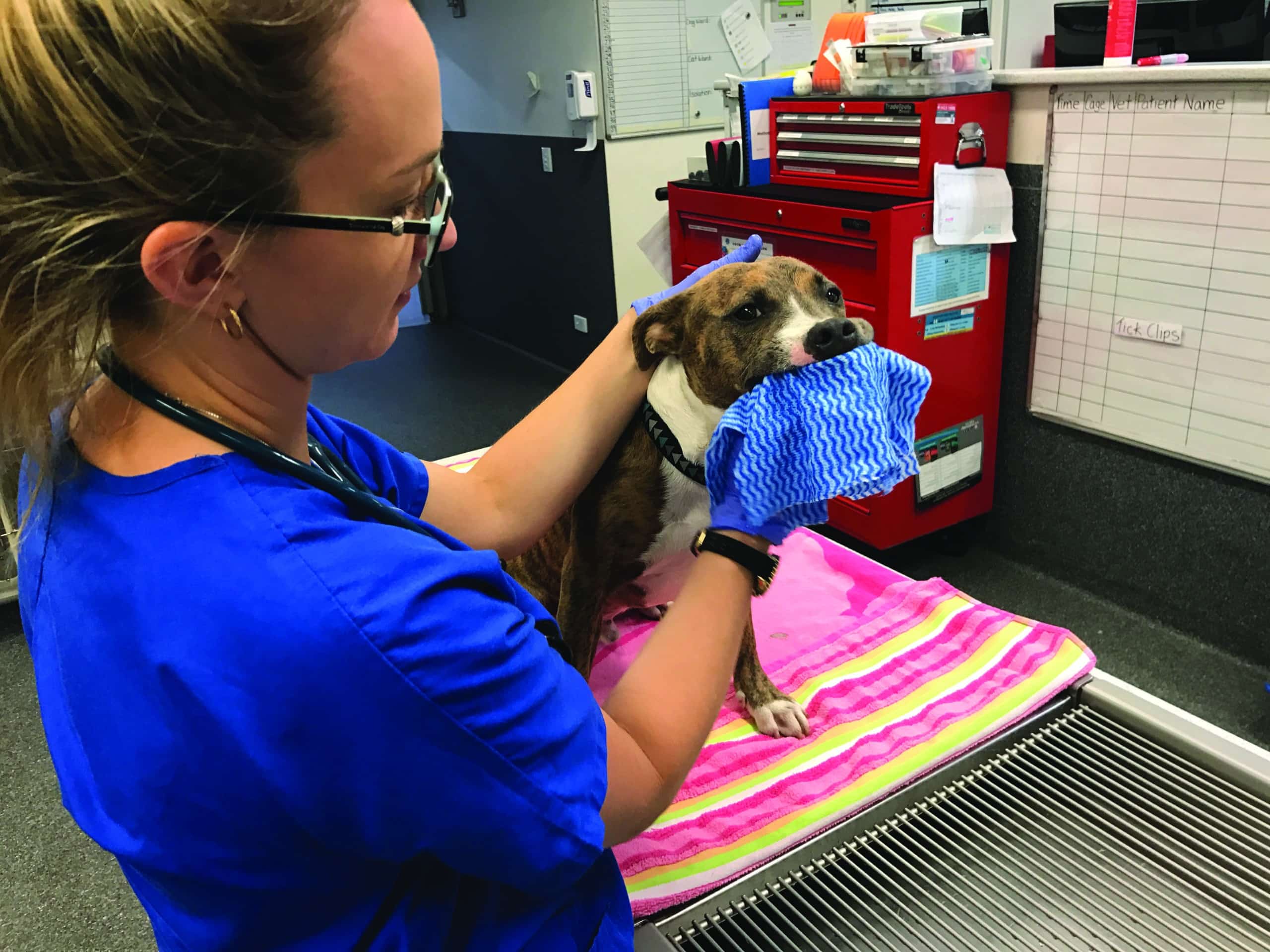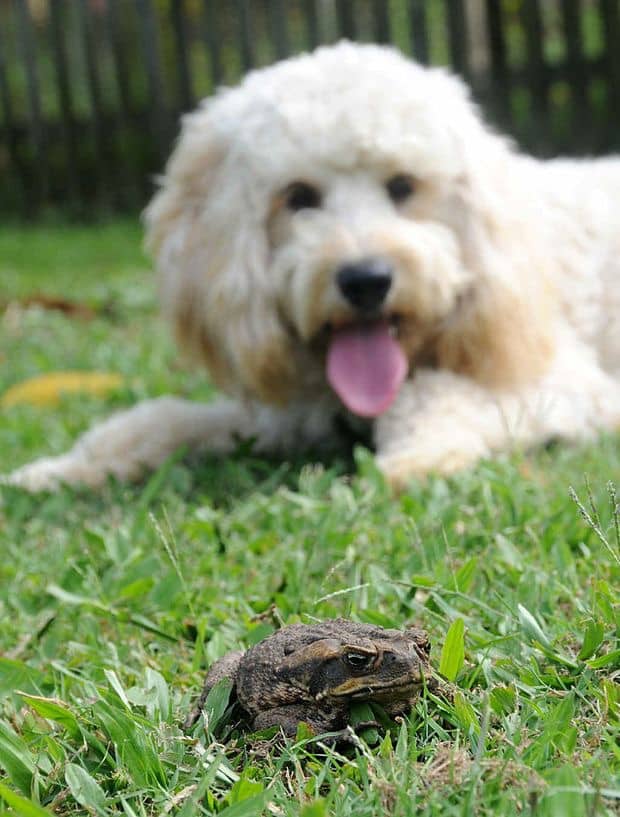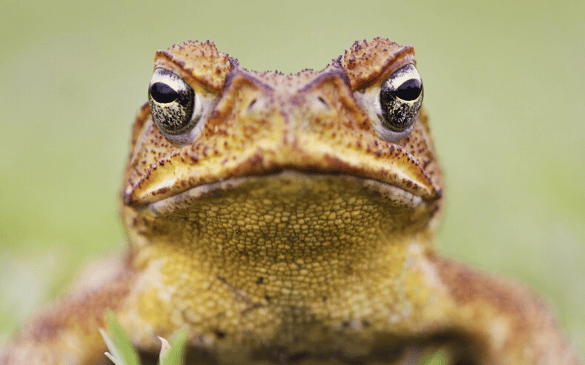Cane toads – a threat to our pets and wildlife.
Australia is home to some of the most dangerous and poisonous animal in the world. One in particular that poses a threat to our pets and wildlife is the cane toad. Every year our team of vets at Animal Emergency Service treats thousands of cases of dogs who have been poisoned by cane toads.
This guide will provide you with information on the signs and symptoms of toad toxicity, what to do if your dog comes in contact with a cane toad, and is the ultimate guide to toad toxicity for dogs in Australia.
What you’ll learn
- Where are cane toads found?
- How to identify a cane toad
- Are all toads poisonous to dogs?
- Are dead cane toads still poisonous?
- How does poisoning occur?
- What are the signs of cane toad poisoning?
- How long does cane toad poisoning take to kill a dog?
- How do I treat cane toad poisoning in my dog?
- How is cane toad poisoning treated by vets?
- Can I prevent my dog from coming into contact with cane toads?
- What to do if you have cane toads on your property
Where are cane toads found?
Cane toads (scientific name: rhinella marina, formally bufo marinus), also known as the Giant toad and Marine toad, are an introduced species to Australia. Their native habitat extends from the southern United States to tropical South America. In June 1935 the Australian Bureau of Sugar Experimental Stations imported a small breeding sample of cane toads from Hawaii. The aim was for them to eradicate native beetles, collectively known as cane beetles, that were destroying sugarcane crops in Queensland. The cane toads successfully reproduced and by August approximately 3,000 were released in sugarcane plantations. However, they didn’t live up to the expectation of controlling the beetle population, and instead reproduced and spread at a rapid rate.
In their native country their numbers are manageable, however, with few natural predators, their ability to breed easily, and the abundance of food, they have thrived with their numbers in Australia well into the millions. They are considered pests, with the government putting eradication measures in place.
Today, cane toads can be found throughout Queensland and into coastal New South Wales, the top end of the Northern Territory, and the Kimberley region of Western Australia. It is estimated they are moving westward at 40-60km per year. They are most active in warmer months.

How to identify a cane toad
The colour of cane toads can vary from grey, yellowish, olive-brown or a reddish-brown, with their stomach being pale with a dark mottling. They are large, heavily-built amphibians with dry, warty or bumpy skin who sit upright. However, male cane toads are smaller and have wartier skin than their female counterparts. They have a bony head with bony ridges over their eyes which meet above their snout. Their back feet have leathery webbing between the toes, while their front feet are unwebbed. On each shoulder behind their eardrums, cane toads have large swellings, these are their parotoid glands where their poison is stored. They cannot jump as high, fast or as far as native frogs can jump.

Younger cane toads have a smooth dark skin with darker patches without the swollen parotid glands of adults, and can often be mistaken for native frogs.
Adult toads are nocturnal and are more active during the summer months of the year.
Are all toads poisonous to dogs?

Cane toads are also dangerous to our native wildlife, killing them into the thousands. Their toxin has been known to kill frogs, quolls, snakes, goannas, and even crocodiles. Despite this, they are yet to send any native Australian animal into extinction. However, in areas where there is a high population of cane toads there is a decline in the number of certain native wildlife, and in some cases local extinction. Particularly of quolls, goannas and some species of snakes.
Are dead cane toads still poisonous?
At all stages of their lifecycle cane toads are poisonous. From eggs to tadpoles to adults, and even dead dried cane toads, the ingestion of their toxin can be fatal, or at least cause serious symptoms. Their toxins break down extremely slowly, and only once they are completely decomposed are they safe.
If you do come across a dead cane toad it is important to dispose of it properly. This being either buried deep enough that your pet/s can’t dig them up, or thrown out with the garbage.
How does poisoning occur?
Poisoning occurs when a dog comes in contact with a cane toad through ‘mouthing’ the toad; through biting or licking. When a cane toad is attacked or threatened they release a potent and fast-acting toxin, milky white in colour, from their parotid glands. This toxin, called bufotoxin and is made up of adrenaline, serotonin, and tryptophan like compounds, is also present in their body tissues as well. They can also squirt the poison up to two metres.
The toxin elicits its effects when it is absorbed via the mucous membranes, most commonly the gums but also via the eyes, nose and tongue. It is very rarely ingested. For example, if a cane toad is ‘mouthed’ the toxin will stick to the tongue and gums your pet, which rapidly absorbs across the mucous membranes and into the bloodstream where it targets the heart, gastrointestinal tract, and nervous system.
It is unlikely to see cane toad poisoning cats, but it does happen. Signs and symptoms of toad toxicity in cats is very similar to what dogs experience, however, there are a couple of signs unique to cats. Poisoning in dogs is much more common, particularly in puppies as they seem unable to resist investigating and chasing jumping toads.

What are the signs and symptoms of cane toad poisoning
Symptoms of cane toad poisoning are dependent on the amount of toxin absorbed and the length of time from when your pet was exposed to the toxin. The cane toad venom contains three different toxin forms which target the cardiac and nervous system. If only a small dose is absorbed the symptoms your pet is likely to experience is similar to those of a psychedelic drug, and is unlikely to be fatal. In larger doses, however, dogs and cats will experience a range of more severe symptoms, and in extreme cases can lead to death if not treated quickly.
Unfortunately, many of these signs and symptoms of toad toxicity are very similar to symptoms of other types of poisonings. Unless you saw your dog bit or lick a cane toad, or saw a toad near your pet, you and your vet will need to work together to diagnose the problem.
These signs and symptoms can include:
Drooling or foaming at the mouth
- Red and slimy gums
- Pawing at mouth
- Vomiting
- Disorientation
- Dilated pupils
- Increased heart rate
- Panting or difficulty breathing
- Wobbly gait or loss of coordination
- Muscle twitches and tremors
- Part of body (legs) or whole-body going rigid
- Seizures
- High body temperature
- Death
For a more in-depth look into the signs and symptoms of cane toad poisoning, visit our Toad Toxicity blog.
How long does cane toad poisoning take to kill a dog?
There is no firm answer to this question, as it depends on how much toxin has been absorbed and the size of the dog. Generally speaking, the adult cane toad has enough toxin to kill an average-sized dog in 15 minutes. The smaller the dog, or cat, the more seriously affected they will be. If your dog does come into contact with the toxin, early intervention is crucial for recovery.
How do I treat cane toad poisoning in my dog?
If you believe your pet has come into contact with a cane toad and is showing any of the above signs or symptoms, follow these steps:
- Using a damp cloth, wipe the inside of their mouth until the slimy coating has been removed – usually this takes 10 to 20 minutes
- Never use a hose to flush the toxin from their mouth – as this can make them inhale the water causing life-threatening pneumonia
- Take them to the vet immediately
For more detailed instructions, visit our What to do if Your Pet Licks a Toad blog.

In mild cases, the above first aid treatment steps will be all that is needed. However, in all cases of suspected toad poisoning your dog should visit the vet immediately as the survival rate from toad poisoning decreases rapidly the longer you wait.
Nurse Amanda explains the symptoms of cane toad poisoning and takes you through first aid treatment you can give your pet
How is cane toad poisoning treated by vets?
If your dog has licked, bitten or eaten a cane toad, it is vital you take them to a vet immediately. Upon arrival your vet will assess how severely they have been poisoned to determine the best treatment option to take.
In less severe cases, such as drooling and/or vomiting the following steps will be taken:
- Decontamination by continued wiping of the mouth to reduce further toxin absorption
- Medications to stop vomiting and/or to stabilise heart rate
- Intravenous fluids to assist with diuresis of the toxin and maintain blood pressure
In severe cases, such as seizures, tremors, rigidity, or disorientation; along with the above treatments the below measures will also be taken:
- Oxygen therapy for those with breathing difficulties
- Medications to control seizures
- Active cooling as most animals have an elevated body temperature from increased muscle contractions
- Blood tests to assess severity of illness and concurrent organ damaged
- Electrocardiograph (ECG) to assess for changes in heart rhythem
It should be noted that you can’t treat toad poisoning by inducing vomiting, due to the toxin usually being absorbed through the mucous membranes – not the stomach.
If your dog is showing signs of toad toxicity but you didn’t see them come in contact with a toad or see a toad nearby, it is still recommended you take them to a vet. With no specific test available to confirm a toad toxicity, it is generally a diagnosis made via physical exam. However vets may perform general blood work, radiographs (x-rays), and electrocardiograms, to help determine treatment plans.
How to prevent your dog coming into contact with cane toads
There are a number of measures you can put in place to lessen the chances of your dog/s coming in contact with cane toads. Below we’ve listed just a few tactics:
Dogs can ingest the toxin just from eating food or drinking water a toad has come in contact with
- Use a raised water bowl and change the water frequently
- Keep your pets inside at night, or in a section of your yard which is easy to keep free of cane toads
- Take them out for toilet breaks on a lead with a flashlight to ensure they are safe
- Teach your dog to stay away from cane toads, while effective for some dogs it isn’t for others
- Be vigilant during the wetter seasons of the year, as this is when toads are most active
- Cane toads eat anything, including pet food, so we recommend not keeping partially full food bowls outside
- Cover swimming pools
- Turn off as many outside lights as possible
- Place a mesh screen around the outside of your fence. Bury the screen by at least 10cm and extend it by at least 50cm
- Try and trap toads with funnel traps along your fence
What to do if you have cane toads on your property
If you find a cane toad on your property remove your pets and any children from the area immediately to avoid them coming into contact with cane toad and its poison, then humanely euthanise the toad.
How to humanely euthanise a cane toad
As the cane toad is considered a pest and is a serious threat to our ecosystem, wildlife and pets, the RSPCA recommends humanely euthanising once the possibility of being a native frog has been ruled out. There are two methods for euthanising cane toads RSPCA recommends:
- Eugenol
The chemical Eugenol, found in the product Croaked, when applied directly to cane toads kills them safely, quickly, and humanly. - Stepped Hypothermia
This is the process of placing the cane toad into a refrigerator for a period of time before moving it into a freezer, which will effectively kill the cane toad painlessly.
For full instructions on how to humanely euthanise a cane toad, please download RSPCAs fact sheet.
If you believe your pet has been poisoned by a cane toad, visit your nearest Animal Emergency Service hospital or your local vet immediately.
For more information about what is toxic to pets, visit our Pets and Poisons Guide.


 Drooling or foaming at the mouth
Drooling or foaming at the mouth Dogs can ingest the toxin just from eating food or drinking water a toad has come in contact with
Dogs can ingest the toxin just from eating food or drinking water a toad has come in contact with